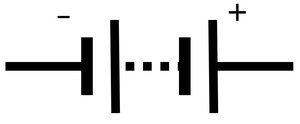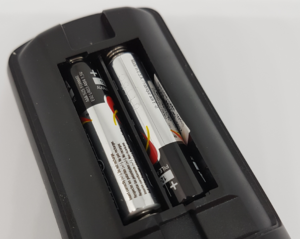Difference between revisions of "Battery"
| (One intermediate revision by one other user not shown) | |||
| Line 47: | Line 47: | ||
: A [[battery]] made from [[Electrical Cell|electrical cells]] connected in [[Series Circuit|series]] gives a greater [[Potential Difference|potential difference]] allowing it to provide a greater [[Electrical Current|current]]. | : A [[battery]] made from [[Electrical Cell|electrical cells]] connected in [[Series Circuit|series]] gives a greater [[Potential Difference|potential difference]] allowing it to provide a greater [[Electrical Current|current]]. | ||
: A [[battery]] made from identical [[Electrical Cell|electrical cells]] connected in [[Parallel Circuit|parallel]] will have the same [[Potential Difference|potential difference]] as one single [[Electrical Cell|cell]] but will last much longer as it has a greater store of [[Chemical Potential Energy Store|chemical potential energy]]. | : A [[battery]] made from identical [[Electrical Cell|electrical cells]] connected in [[Parallel Circuit|parallel]] will have the same [[Potential Difference|potential difference]] as one single [[Electrical Cell|cell]] but will last much longer as it has a greater store of [[Chemical Potential Energy Store|chemical potential energy]]. | ||
| + | |||
| + | ===References=== | ||
| + | ====AQA==== | ||
| + | :[https://www.amazon.co.uk/gp/product/1471851370/ref=as_li_tl?ie=UTF8&camp=1634&creative=6738&creativeASIN=1471851370&linkCode=as2&tag=nrjc-21&linkId=01c69b0ae058f809cf636033e6ba793e ''Batteries, page 47, GCSE Physics, Hodder, AQA ''] | ||
| + | :[https://www.amazon.co.uk/gp/product/1782945571/ref=as_li_tl?ie=UTF8&camp=1634&creative=6738&creativeASIN=1782945571&linkCode=as2&tag=nrjc-21&linkId=9e29fad914244909903e5e93f8a01d57 ''Batteries, page 64, GCSE Chemistry; The Revision Guide, CGP, AQA ''] | ||
| + | :[https://www.amazon.co.uk/gp/product/0198359381/ref=as_li_tl?ie=UTF8&camp=1634&creative=6738&creativeASIN=0198359381&linkCode=as2&tag=nrjc-21&linkId=47c8d1ae58d8b3a5e2094cd447154558 ''Batteries, pages 120-121, GCSE Chemistry; Third Edition, Oxford University Press, AQA ''] | ||
| + | :[https://www.amazon.co.uk/gp/product/1471851346/ref=as_li_tl?ie=UTF8&camp=1634&creative=6738&creativeASIN=1471851346&linkCode=as2&tag=nrjc-21&linkId=3ac654f4b0da781c49c855a1af4c92ea ''Batteries, pages 137-8, GCSE Chemistry, Hodder, AQA ''] | ||
| + | :[https://www.amazon.co.uk/gp/product/1782945962/ref=as_li_tl?ie=UTF8&camp=1634&creative=6738&creativeASIN=1782945962&linkCode=as2&tag=nrjc-21&linkId=476bb5c8d1dfb5c08ac81b6d4d1c98d8 ''Batteries, pages 186-189, GCSE Chemistry, CGP, AQA ''] | ||
| + | :[https://www.amazon.co.uk/gp/product/1471851354/ref=as_li_tl?ie=UTF8&camp=1634&creative=6738&creativeASIN=1471851354&linkCode=as2&tag=nrjc-21&linkId=9012a0d354024419214fb3ad5ac44ba0 ''Batteries, pages 293, 302, GCSE Combined Science Trilogy 1, Hodder, AQA ''] | ||
| + | :[https://www.amazon.co.uk/gp/product/1782946403/ref=as_li_tl?ie=UTF8&camp=1634&creative=6738&creativeASIN=1782946403&linkCode=as2&tag=nrjc-21&linkId=32a0abb60dff015b15b50e9b1d7b4644 ''Batteries, pages 60, 68, GCSE Combined Science Trilogy; Physics, CGP, AQA ''] | ||
| + | :[https://www.amazon.co.uk/gp/product/1782945970/ref=as_li_tl?ie=UTF8&camp=1634&creative=6738&creativeASIN=1782945970&linkCode=as2&tag=nrjc-21&linkId=a120d24dcc7cc7a58192069a3aafc1d2 ''Batteries, pages 62, 70, GCSE Physics; The Complete 9-1 Course for AQA, CGP, AQA ''] | ||
| + | :[https://www.amazon.co.uk/gp/product/1471851370/ref=as_li_tl?ie=UTF8&camp=1634&creative=6738&creativeASIN=1471851370&linkCode=as2&tag=nrjc-21&linkId=01c69b0ae058f809cf636033e6ba793e ''Batteries; circuit symbol, page 38, GCSE Physics, Hodder, AQA ''] | ||
| + | :[https://www.amazon.co.uk/gp/product/1471851370/ref=as_li_tl?ie=UTF8&camp=1634&creative=6738&creativeASIN=1471851370&linkCode=as2&tag=nrjc-21&linkId=01c69b0ae058f809cf636033e6ba793e ''Batteries; energy transfers, page 4, GCSE Physics, Hodder, AQA ''] | ||
| + | :[https://www.amazon.co.uk/gp/product/0008158770/ref=as_li_tl?ie=UTF8&camp=1634&creative=6738&creativeASIN=0008158770&linkCode=as2&tag=nrjc-21&linkId=ec31595e720e1529e49876c3866fff6e ''Battery, page 52, GCSE Physics; Student Book, Collins, AQA ''] | ||
| + | |||
| + | ====OCR==== | ||
| + | :[https://www.amazon.co.uk/gp/product/0198359829/ref=as_li_tl?ie=UTF8&camp=1634&creative=6738&creativeASIN=0198359829&linkCode=as2&tag=nrjc-21&linkId=90e8d7b4f039d53035238fa0320fe00b ''Batteries, pages 8-9, 56, 123, 248, 266, Gateway GCSE Chemistry, Oxford, OCR ''] | ||
| + | :[https://www.amazon.co.uk/gp/product/0198359837/ref=as_li_tl?ie=UTF8&camp=1634&creative=6738&creativeASIN=0198359837&linkCode=as2&tag=nrjc-21&linkId=3c4229e8b023b2b60768e7ea2307cc6f ''Batteries, pages 8-9, 96, 100, Gateway GCSE Physics, Oxford, OCR ''] | ||
Latest revision as of 18:35, 30 November 2019
Contents
Key Stage 2
Meaning
A battery is two or more electrical cells connected together.
About Batteries
- Whenever two or more electrical cells are in the same circuit they are called a battery.
- A battery is made if two or more electrical cells are plugged in to the same device.
| A 9V 'square' battery is made of 6 electrical cells. | The symbol for a battery. |
Key Stage 3
Meaning
A battery is more than two electrical cells, which each have a chemical potential energy store, connected together in an electrical device.
About Batteries
- A battery made from electrical cells connected in series gives a greater potential difference allowing it to provide a greater current.
- A battery made from identical electrical cells connected in parallel will have the same potential difference as one single cell but will last much longer as it has a greater store of chemical potential energy.
| A 9V 'square' battery is made of 6 electrical cells. Each cell has a potential difference of 1.5V. | The symbol for a battery. |
Key Stage 4
Meaning

The symbol for a battery.
A battery is more than two electrical cells, which each have a chemical potential energy store, connected together in an electrical device.
About Batteries
- An battery is a source of direct current.
- A battery made from electrical cells connected in series gives a greater potential difference allowing it to provide a greater current.
- A battery made from identical electrical cells connected in parallel will have the same potential difference as one single cell but will last much longer as it has a greater store of chemical potential energy.
References
AQA
- Batteries, page 47, GCSE Physics, Hodder, AQA
- Batteries, page 64, GCSE Chemistry; The Revision Guide, CGP, AQA
- Batteries, pages 120-121, GCSE Chemistry; Third Edition, Oxford University Press, AQA
- Batteries, pages 137-8, GCSE Chemistry, Hodder, AQA
- Batteries, pages 186-189, GCSE Chemistry, CGP, AQA
- Batteries, pages 293, 302, GCSE Combined Science Trilogy 1, Hodder, AQA
- Batteries, pages 60, 68, GCSE Combined Science Trilogy; Physics, CGP, AQA
- Batteries, pages 62, 70, GCSE Physics; The Complete 9-1 Course for AQA, CGP, AQA
- Batteries; circuit symbol, page 38, GCSE Physics, Hodder, AQA
- Batteries; energy transfers, page 4, GCSE Physics, Hodder, AQA
- Battery, page 52, GCSE Physics; Student Book, Collins, AQA

